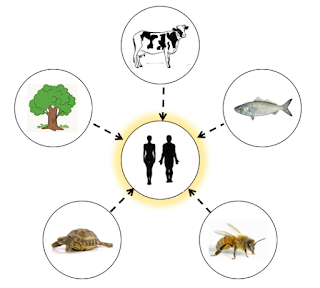Framing for apathy and disengagement: The "biodiversity erosion"
Photo by Corrado Alisonno, licensed under CC BY-NC-SA 2.0
One of the main purposes of environmental organizations, environmental journalism and conservation science is to get people to care about nature. People should care about nature because nature is beautiful, glorious and magnificent; because nature should be respected; because nature is being destroyed; because we cannot live without nature; because we are inseparable from nature, among many other reasons.
Before we start, I want you to keep in mind this quote from Aldo Leopold, who is usually recognized as one of the most important environmental philosophers of the past century. In one of his books from 1949, he stated that:
“We can only be ethical in relation to something we can see, understand, feel, love, or otherwise have faith in.”
Today I would like to bring your attention to one of the key concepts present in current environmental discourse: Biodiversity.
Biodiversity is a new word that was invented in 1985 by Walter G. Rosen as short for biological diversity. With its three decades of existence, biodiversity is a word that has an extremely short history in the English language, so, as you might expect, it is not universally known nor widely-used in everyday language.
Despite its numerous definitions, biodiversity is commonly understood as: "the variety of life on Earth, it includes
all organisms, species, and populations; the genetic
variation among these; and their complex assemblages of
communities and ecosystems". (Source: UN Environment)
Biodiversity is thus a mass noun because it comprises all the organisms on Earth and their complex assemblages. Just by its definition we can infer that we, as the Homo Sapiens species, are part of biodiversity. At first sight, it might seem really odd to create a completely new word to convey what we more readily know as "Life on Earth" or simply as "Life". However, as the word suggests it, its main idea is to emphasize the fact that life is diverse.
In practice, the term biodiversity has provided practical tools for its measurement and quantification. Thanks to those tools, now we know that there are places with great biodiversity (usually called hotspots) and also places with poor biodiversity.
In practice, the term biodiversity has provided practical tools for its measurement and quantification. Thanks to those tools, now we know that there are places with great biodiversity (usually called hotspots) and also places with poor biodiversity.
However, since it is a concept that emerged from the scientific community, it is highly abstract and very difficult to relate to our subjective experiences of nature. Just so you get a hint of the point that I'm trying to make, try to answer the following question:
- Which of these two sentences makes you care more?
- We are facing a biodiversity crisis.
- We are facing a crisis of life on Earth.
Indeed, there are profound differences between the words biodiversity and life. The word biodiversity can be understood with the notion of "the trace". A trace occurs "when a discourse represents the natural world [...] in a way which obscures it, leaving a faint trace rather than a vivid image" (Stibbe, 2015, p.155). In our case, we may notice that when the word biodiversity is employed, it very hardly evokes feelings, emotions, relations, sensations, memories and colors we might have experienced when confronted to the beauty and diversity of life. In this sense, it is a relatively non-evocative and dispassionate concept, arguably because it was conceived for scientific purposes. Here, if we take Aldo Leopold's statement seriously, it would be certainly difficult to be ethical towards biodiversity. In other words, it would be hard to care about a concept that does not arouse our imagination to evoke our intimate and collective experiences of nature.
The disembodiment of the word biodiversity becomes most evident when used in a phrase commonly used by conservation scientists, the biodiversity erosion. Erosion is "the fact of soil, stone, etc. being gradually damaged and removed by the waves, rain, or wind" (Cambridge dictionary). Erosion is thus mostly used to talk about rock formations (non-living things) being modified by the action of natural forces. If biodiversity erosion actually refers to industrial activities poisoning and eradicating birds, insects, mammals, fish, etc. and the destruction of their respective habitats, then one might say that this formulation is a very effective and powerful euphemism.
Furthermore, the idea of biodiversity posits that the unity of value is the type (the species) and never the individuals. In other words, moral judgments around biodiversity are framed so that we care only when species are threatened of extinction, and not when animal or vegetal populations are killed and displaced for the sake of urban and industrial expansion.
Furthermore, the idea of biodiversity posits that the unity of value is the type (the species) and never the individuals. In other words, moral judgments around biodiversity are framed so that we care only when species are threatened of extinction, and not when animal or vegetal populations are killed and displaced for the sake of urban and industrial expansion.
On the other hand, the word life is a radically intimate word. You and I we are both alive in this moment and we know what it is and how it feels to be alive. We naturally care about our own lives as well as the lives of others. And we may naturally care about the preservation of life on Earth, since we are life on Earth.
To sum up, we were able to shed some light onto how biodiversity is a disembodied new word that can hardly make us reminisce our subjective experiences within nature. Thus, it can hardly lead us to care profoundly about life on Earth. In turn, employing biodiversity in environmental discourse and text will hardly create intimate, long-term engagements towards protecting life on Earth.
References
Leopold, A. (1949). A Sand County almanac, and sketches here and there.
Stibbe, A. (2015). Ecolinguistics: Language, ecology and the stories we live by. Routledge.





Comments
Post a Comment